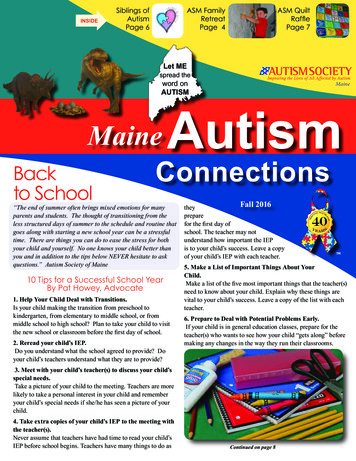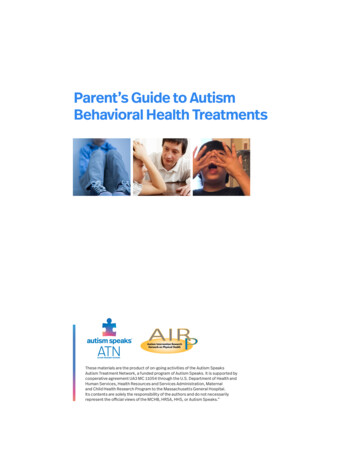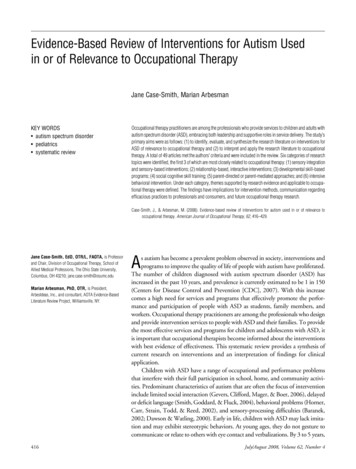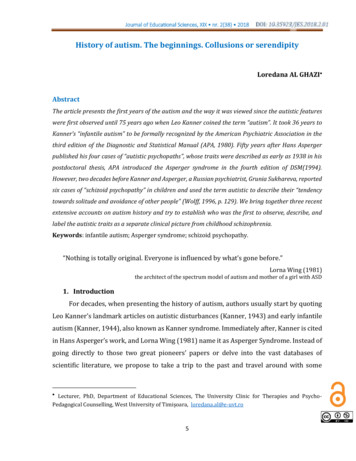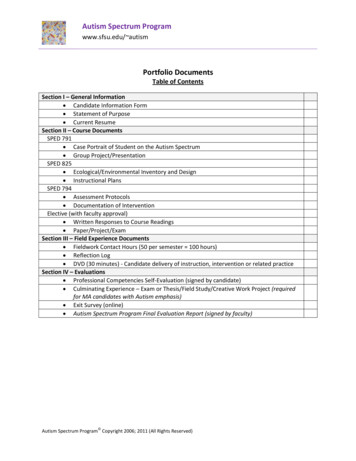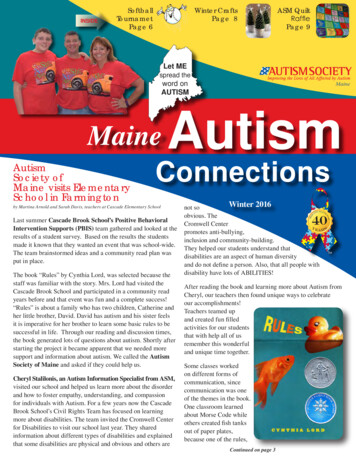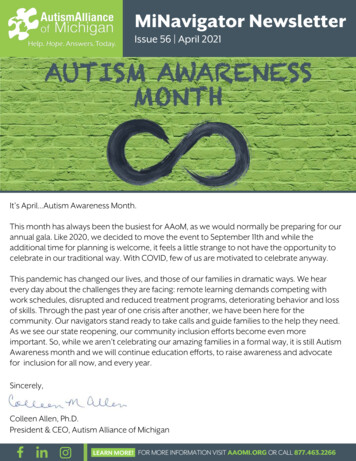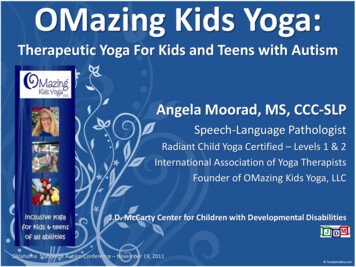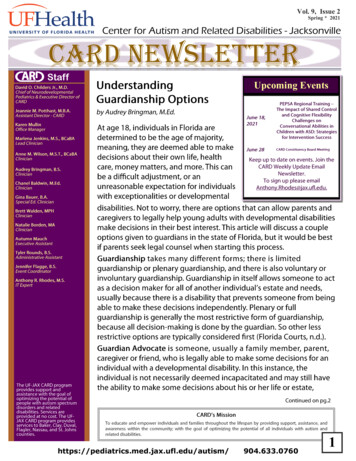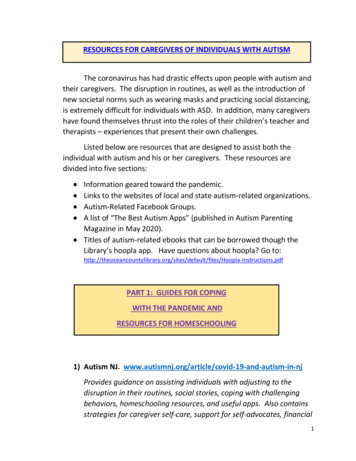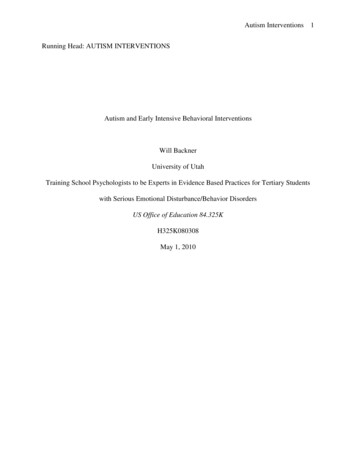
Transcription
Autism InterventionsRunning Head: AUTISM INTERVENTIONSAutism and Early Intensive Behavioral InterventionsWill BacknerUniversity of UtahTraining School Psychologists to be Experts in Evidence Based Practices for Tertiary Studentswith Serious Emotional Disturbance/Behavior DisordersUS Office of Education 84.325KH325K080308May 1, 20101
Autism Interventions2AbstractAutism is characterized by severe impairment in reciprocal social interaction skills andcommunication skills and by the presence of stereotyped behavior, interests, and activities. It is aspectrum disorder so presentation is variable based on severity of symptoms. Autism awarenessis increasing in the general public and with it there has been an increase in unproven treatments.Often these treatments are expensive and time consuming so it is essential that efforts be focusedon treatments that have been researched and validated. This article discusses the diagnosticcriteria, characteristics, prevalence, and evidence for behavioral interventions for autism.
Autism Interventions3AutismIntroductionAutism is a low incidence disability affecting verbal and nonverbal communication andsocial interaction, which is generally evident before age 3 (Shriver, Allen, & Mathews, 1999).There is currently no cure but autism can be managed with a combination of behavioral,educational, and biological interventions (Gresham, Beebe-Frankenberger, & MacMillan, 1999).The goal of comprehensive treatments is to change the course of autism and reduce the level ofthe long-term disability associated with the disorder. Families are increasingly seeking outcomprehensive programs to treat autism so they need information on the empirical basis oftreatments in order to make informed decisions. There are many new ideas about potential curesand treatments for autism, and the majority do not have a well-established empirical basis(Rogers, 1998). Literature on autism has increased recently but it is a mix of science andunproven theories. Many of these reports are being made available through popular magazines,television shows, and the Internet. With so many choices available, it is difficult for parents tochoose which interventions are proven and worth their time and money. An early start tointervention and individualization of services has been identified in many reports as key tosuccessful interventions (Iovannone, Dunlap, Huber, & Kincaid, 2003). Additionally, a benignbut ineffective treatment can be harmful if it takes the place of an effective treatment that couldhave been used (Gresham et al., 1999; Rogers, 1998). Some treatments such as Holding Therapy,Gentle Teaching, Options, Floor Time, and Sensory Integration lack scientific validation, asound theoretical orientation, or have been shown to lack efficacy (Heflin & Simpson, 1998).Even empirically sound treatments such as Applied Behavior Analysis (ABA) are controversial
Autism Interventions4because of claims of autism recovery (Heflin & Simpson, 1998). Each person with autism is aunique individual so we need to beware of programs that ignore this (Freeman, 1997).Effectively assessing autism requires that professionals are knowledgeable about thecharacteristics of autism (Shriver et al., 1999). Additionally, professionals need to beknowledgeable about the effectiveness of interventions in order to help parents distinguishbetween validated and unvalidated treatments (Rogers, 1998).Definition and ClassificationAutism is a biologically based neurodevelopmental disorder that is a lifelong impairmentfor most individuals (Erba, 2000; Freeman, 1997). It occurs in all parts of the world and in alltypes of families. No social or psychological characteristics have been found to be associatedwith autism (Freeman, 1997). There is no biological marker for autism that has currently beenidentified (Bryson & Smith, 1998). Therefore, it is a behavioral syndrome that is diagnosed by itssymptoms (Shriver et al., 1999). Its cause is unknown but aspects of autism are heritable. It isknown that it involves multiple genes and has a large phenotypic variation, which may beinfluenced by environmental factors (Johnson, Myers, & Council on Children with Disabilities,2007). In fact, siblings of children with autism are 20 to 50 times more at risk for developingautism (Volkmar, Chawarska, & Klin, 2005).Autistic disorder is one of the five subtypes of pervasive developmental disorders listedin the Diagnostic and Statistical Manual of Mental Disorders (DSM-IV). The other four subtypesare Rett’s Disorder, Childhood Disintegrative Disorder, Asperger’s Disorder, and PervasiveDevelopmental Disorder Not Otherwise Specified (PDD-NOS). According to the DSM-IV, allsubtypes of pervasive developmental disorders are characterized by severe impairment in
Autism Interventions5reciprocal social interaction skills and communication skills and by the presence of stereotypedbehavior, interests, and activities (American Psychiatric Association, 1994). In order to meet adiagnosis of autism, children have to show abnormal development before age 3, and delays orabnormal functioning in social development, language, and restricted patterns of behaviors,interests, or activities (Freeman, 1997).CharacteristicsThe clinical presentation of autism is variable. It is a spectrum disorder with a continuumof symptoms that vary widely (Freeman, 1997). Behavioral manifestations of autism vary withthe severity of autism and the degree of mental retardation and there is a difference in theexpression and severity of symptoms between children (Bryson & Smith, 1998). Characteristicsoften associated with autism include repetitive activities, stereotypical movements, resistance toenvironmental change, and unusual response to sensory experience (Shriver et al., 1999). Othersymptoms are a lack of mutual gazing, reciprocal smiling, or pointing to share interest withothers (Bryson & Smith, 1998). Children with autism often show deficits in joint attention andsocial relatedness to others. They do not seek connectedness and are content to be alone. Oftenthey have deficits in eye contact and ignore bids for attention. They may have difficulty sharingthe emotional states of others and show deficits in theory of mind. Young children with autismmay not follow a point or eye gaze. To indicate an object that they desire, they may take a parentby the hand and lead them to it instead of pointing at it. They may not respond to their name, inthe absence of a hearing deficit. Children with autism also may have delayed pretend play skillsand restricted interests or obsession with certain things such as trains or dinosaurs and they mayknow far more details than typical children (Barbaresi, Katusic, & Voigt, 2006; Johnson, Myers,
Autism Interventions6& Council on Children with Disabilities, 2007).Associated Medical and Psychiatric ConditionsIt has been reported that 25-30% of people with autism have other medical conditions(Bryson & Smith, 1998). The most common condition is mental retardation, which has reportedrates of 50 to 75% of cases (Bryson & Smith, 1998; Freeman, 1997). However, when allpervasive developmental disorders are considered, the majority of children with an autismspectrum disorder do not have mental retardation since the rates drop to 26 to 29% (Bryson &Smith, 1998; Johnson et al., 2007). Other medical conditions common in autism are seizuredisorders as reported in 30% of the population, fragile X syndrome as reported in 2 to 5% of thepopulation, and tuberous sclerosis as reported in 1 to 3% of the population (Tsai, 1996). Themean rate of epilepsy in autistic populations is 16.8% (Volkmar, Lord, Bailey, Schultz, & Klin,2004). Other common medical conditions in persons with autism include blindness, deafness,and neurofibramitosis (Bryson, 1998). Motor incoordination and severe allergies also affectmany people with autism (Freeman, 1997).There are many reported psychiatric symptoms associated with autism. These includehyperactivity, poor attention, anxiety, compulsive behaviors, obsessions, compulsions, and sleepproblems. Psychiatric conditions common in autism are unipolar and bipolar affective disorders,obsessive-compulsive disorder, schizophrenia, Tourette syndrome, and attention deficithyperactivity disorder (Tsai, 1996). It is not clear if these behavioral and psychiatric symptomsare developmentally related to autism. Usually only the higher functioning autistic patientsreceive the additional DSM-IV diagnoses. Clinicians are generally reluctant to give additionaldiagnoses to lower functioning people with autism because they are not able to provide
Autism Interventions7diagnostic information about their symptoms through interview or self-report scales (Tsai, 1996).PrevalenceNo association between autism and social class has been found in epidemiological studies(Volkmar et al., 2004). However, it has been found that the condition is more common in males.The ratio of autism reported in males as compared to females is 3 to 5:1 (Bryson & Smith, 1998;Fombonne, 2005). In recent years, there has been a dramatic increase in the number of childrenidentified with autism worldwide. In the first survey of autism prevalence in 1966, the rate was4.5/10,000 (Croen, Grether, Hoogstrate, & Selvin, 2002). In recent studies, the rate has beenstated to be as high as 6/1,000 (Johnson et al., 2007). Prevalence estimates for all pervasivedevelopmental disorders is 27.5/10,000 but there is a large variance in prevalence found betweenstudies (Fombonne, 2003; Williams, Higgins, & Brayne, 2006). Surveys of prevalence ofpervasive developmental disorders indicate that current prevalence estimates for individualdisorders are 13/10,000 for autistic disorder, 21/10,000 for PDD-NOS, and 2.6/10,000 forAspergers (Fombonne, 2005).There is a controversy about whether increase in the prevalence of autism is due toincrease in the incidence of the condition (Bryson & Smith, 1998). The appearance of anincrease in autism is likely due to changes in the concepts, definitions, service availability, andawareness of autism spectrum disorders to the general public and professionals (Barbares et al.,1998; Fombonne, 2005). Direct analysis of data from the Office of Special Education shows thatautism is increasing in prevalence over time, with a higher prevalence in younger birth cohorts(Newschaffer, Falb, & Gurney, 2005). However, this increase in IDEA autism classification islikely due to school personnel taking advantage of using the category as time goes on
Autism Interventions8(Gernsbacher, Dawson, & Goldsmith, 2005). An increase of 17.6% per year in California is alsolikely due to more children accessing services rather than increased awareness (Croen et al.,2002; Fombonne, 2005). Within the same birth cohort, prevalence rises as age of cohortincreases, which suggests that there is an increase in identification rather than an increase inprevalence. The current data does not support an increase in the incidence of autism, but thepower to detect time trends is limited in the current data sets (Fombonne, 2005).Assessment and DiagnosisEarly identification of autism is important because early intervention may be moreeffective for children with autism than for children with other developmental disabilities(Barbaresi et al., 2006). Additionally, early identification can provide access to appropriateinterventions, which lead to better prognosis (Freeman, 1997). Even with the importance of earlyidentification, autism is often not diagnosed until children are 3-4 years old (Werner, Dawson,Osterling, & Dinno, 2000). Early markers in autism are evident on video prior to when parentsstarted to suspect problems (Barenek, 1999; Volkmar, 2005). Deficits in joint attention and socialdifficulties are strong predictors of autism in 2-year-olds. Current diagnostic techniques candiagnose it as early as 2 years old, and most diagnoses are stable from this age on (Rogers, 1999;Volkmar, 2005).Recent advances in diagnostic techniques have been able to detect differences betweentypical infants and those with early onset autism at 8-10 months. Autistic infants were much lesslikely to orient when their name was called and less likely to look at another person whilesmiling (Werner et al., 2000). Retrospective analysis of home movies has shown that childrenlater diagnosed with autism show less visual attention to social stimuli, smile less frequently,
Autism Interventions9vocalize less, engage less in object exploration, and are less likely to respond to their own nameas infants. At ages 1 to 3, difficulties in the area of social development, unusual gaze, abnormalplay, and lack of responsivity to speech are able to distinguish children with autism (Volkmar etal., 2005). Examining home videotapes found that measures of social responsiveness andmeasures of sensory-motor functioning were found to discriminate between 9- to 12-month-oldswith autism and those without. Things that discriminated autistic children from others weremouthing, orientation to visual stimuli, social touch aversions, posturing, number of nameprompts, and affect rating. These findings indicate that measures of sensory motor functioningcan be used to augment measure of social responsiveness (Barenek, 1999).Deficits in joint attention differentiated infants with autism from those with mentalretardation and typical infants. Deficits in nonverbal communication and language delaysdistinguished autism from other developmental disorders. These nonverbal delays can includestereotypic speech, echolalia, and scripted speech. Repetitive behaviors are characteristic ofautism but do not differentiate it from other disorders (Barbaresi et al., 2006; Johnson et al.,2007). After 24 months of age, children with autism can be differentiated on several factors: (a)they smile in response to a smile, (b) they respond to their own name, (c) they follow pointing,(d) they look to read faces for information when cheated, (e) they join functional play withminiature toys with an adult, and (f) they initiate requesting nonverbal and verbal behavior(Trillingsgaard, Sørensen, Nemec, & Jørgensen, 2005).Standardized measures can also be used to diagnose autism. The DSM-IV criteria workwell for diagnosing children over age 3, while the Autism Diagnostic Interview-R (ADI-R)works well for diagnosing children over age 4. The Child Autism Rating Scale (CARS) is lessaccurate for children under 2. The M-CHAT has good sensitivity and specificity for a screener
Autism Interventions 10and can be use with young children. Some researchers believe that the best method of diagnosinginfants and young children is an experienced clinician (Volkmar et al., 2005). However, Werneret al. (2000) found that pediatricians were able to correctly classify infants 78% of the time at 1years old but did not perform better than chance at 8-10 months. This suggests that specificdiagnostic probes are necessary for very early identification rather than clinical judgment alone.Controversy Over TreatmentEven with the increase in new information about autism, there is still controversy aboutwhich is the best treatment (Heflin & Simpson, 1998). There are several comprehensivetreatment programs for autism that show positive outcome. These programs report significantacceleration of developmental rates, significant IQ gains, significant language gains, improvedsocial behavior, and reduced symptoms of autism after 1 to 2 years in an intensive preschoolsetting (Rogers, 1996). The term intensive has been defined as one to one instruction for 30-40hours a week for at least 2 years (Weiss, 1999). Some programs even report children beingmainstreamed into general education following treatment. Common comprehensive programsused by community providers are the Lovaas method, ABA, Floor Time, and Treatment andEducation of Autistic and Related Communication Handicapped Children (TEACCH) (Stahmer,Collings, & Palinkas, 2005).Iovannone et al. (2003) found that components of successful interventions are “1.individualized supports and services for students and families, 2. systematic instruction, 3.comprehensible and/or structured environments, 4. specialized curriculum content, 5. afunctional approach to problem behaviors, and 6. family involvement” (p. 153). An additionalcriterion for program evaluation provided by Freeman (1997) is that the only treatment that has
Autism Interventions 11passed the test of time and effectiveness is “structured educational programs geared to theperson's developmental level of functioning” (p. 646). Freeman states that each person withautism is a unique individual so we need to beware of programs that ignore this. Outcome ofthese treatment programs can be measured by quality of life indicators such as the ability to live,work, learn, be mobile, and have fun in a natural setting (p. 646). Even with these tools toevaluate program effectiveness, we need more data before we can conclude that any one programis effective for all children (Freeman).Variables Affecting OutcomeThe goal of comprehensive treatments is to change the course of autism and reduce thelevel of the long-term disability associated with autism (Rogers, 1998). In a review of theliterature, Rogers (1998) found that every study in the literature that has shown significantchanges in children with autism was conducted with children under age 5. Also, children appearto benefit most when treatment is begun between ages 2 and 4 (Rogers, 1996). Harris andHandleman (2000) found that children who entered intervention younger were more likely to bein regular education at follow-up than children who were older. In fact, all children who enteredthe program when they were 48 months or older were in special education at follow-up. Childrenwho were younger than 48 months when they entered treatment had the most favorable outcome.Additionally, children who entered the program younger had higher IQs when they left theprogram. A higher IQ at discharge meant that the child was more likely to be in regulareducation. Harris and Handleman also found that children who had higher IQs at intake weremore likely to be in a regular education setting after treatment. In a retrospective study, Gabriels,Hill, Pierce, Rogers, & Wehner (2001) also found that developmental IQ was predictive of
Autism Interventions 12functioning at follow-up. Rogers (2008) also identifies pretreatment IQ as a predictor oftreatment outcome.In addition to age and IQ, Szatmari, Bryson, Boyle, Streiner, and Duku (2003) found thatearly language and nonverbal skills were predictors of adaptive behavior in communication andsocialization. The predictive ability of these factors is stable through preadolecence. Otherpredictive skills include joint attention skills, functional play skills, cognitive abilities, andseverity of symptoms. Johnson et al. (2007) state that poorer outcome is associated with lack ofjoint attention by 4 years of age and lack of functional speech by 5 years. The amount oftreatment a child receives has also been studied as a moderator of outcome (Rogers & Vismara,2008). The studies Rogers and Vismara reviewed did not find a difference between more or lesshours of treatment using the Lovaas method. Months of treatment duration was the onlysignificant variable found. However, Rogers and Vismara point out that these type of treatmentintensity studies assume that children only learn during therapy, which may not represent theirtrue learning opportunity. Family factors also have been proposed as moderator variables.Gabriels et al., (2001) found that children in families that had higher financial strain had worseoutcomes, and children of parents that had worse coping skills had worse outcome. Weiss (1999)proposed learning rate as a moderator of treatment outcome. It was found that children whoinitially had a low rate of skill acquisition continued to struggle to acquire skills later intreatment. These contradicting reports of moderator variables indicate that the field is still in theprocess of definitively determining which variables moderate and mediate treatment outcomeand the degree of short and long-term improvements that can be expected (Rogers & Vismara).
Autism Interventions 13Review of Comprehensive Treatment ProgramsThere are several reviews of comprehensive early interventions for children with autism(Campbell, 2007; Corsello, 2005; Gresham et al., 1999; Heflin & Simpson, 1998; Reichow &Wolery, 2009; Rogers, 1999, 1996; Rogers & Vismara, 2008). Many researchers state that ABAis the most effective treatment for autism and reviews generally support this claim (Barbaresi etal., 2006; Bryson, 1998; Volkmar et al., 2004; Volkmar et al., 2005). However, the process ofdetermining which treatments are the most efficacious for autism is still in the early stages(Rogers, & Vismara).Rogers and Vismara (2008) review 22 comprehensive treatments for autism publishedbetween 1998 and 2006. They used the classification criteria of Chambless et al. (1996) andNathan and Gordon (2002) to determine if studies are “well-established” or “probablyefficacious.” Of the studies they reviewed, five were randomly controlled trials. However, thesestudies had small sample sizes and examined different treatments. Rogers and Vismara expressconcern over the low number of Nathan and Gordon’s Type 1 studies (studies with randomassignment to a comparison group, blind assessments, clear inclusion criteria, adequate samplesizes, and clearly described statistical methods). It is possible to determine from these studiesthat children with autism experience developmental gains in response to daily interventions. Alack of comparative studies means that the question of which comprehensive treatment forautism is best cannot yet be answered. Rogers and Vismara state that large and well-poweredstudies are badly needed to determine the comparative effects of different treatments for autism.They found that across all studies that they reviewed, language, communication, and IQimproved. This indicates that symptoms of autism can be changed in early childhood. Lovaas’s
Autism Interventions 14discreet trial training intervention approach has been previously shown to be “probablyefficacious.” Rogers and Vismara’s review shows that, with recent replications of this study, theLovaas method can now be considered “well established.” Replications of Lovaas’s study showthat recovery, IQ in normal range and placement in a typical classroom without supports, canhappen in a significant subgroup of children if the intervention is intensive enough and startedearly enough. Another type of study Pivotal Response Training (PRT) was also found to be“probably efficacious.” PRT is a treatment approach that use principles from applied behavioranalysis but uses naturalistic interactions instead of adult-directed mass trial procedures todevelop child motivation and initiative (Rogers & Vismara). Two other studies of comprehensivetreatments, one developmentally based and the other language based, met the criteria for“possibly efficacious.” Replication is needed to further validate their efficacy. Othercomprehensive treatments may be as or more effective than these treatments but other treatmentmethods either lack any peer-reviewed published data or their studies lack strong designs andindependent replication.Rogers and Vismara (2008) also reviewed the literature on medication interventions forautism. They found studies demonstrated that selective serotonin reuptake inhibitors (SSRI) hadsome positive effect in adolescents and adults with autism. Stimulant medication has also shownsome promise in reducing inattention and hyperactivity although there is concern about increasedirritability and stereotypic movements due to the medication. Antipsychotics have previouslybeen shown to reduce aggression, social withdrawal, hyperactivity, and sleep disturbances.However, there is concern about tardive or withdrawal dyskinesia in children with autism. Aconcern about giving medication to children with autism is that there can be large placeboeffects. Additionally, children with autism seem to have a lower response rate to medication than
Autism Interventions 15typically developing children with similar symptoms.Corsello (2005) reviewed several comprehensive early intervention programs for autism.Young children, family involvement, and intensive hours are identified as common elements oftreatment programs. The TEACCH program emphasizes environmental organization and visualsupports. Its goal is to teach independence and developmental skills. A strength of the program isthat it focuses on teaching skills for the lifespan and is a community-based intervention. Itsweakness is a lack of empirical support. There are two studies comparing TEACCH withintervention provided by public education. Both studies showed more improvements on outcomemeasures for the children in the TEACCH program, but the sample sizes were small and thegroups were not randomized. Corsello (2005) also reviewed ABA programs. It is important tonote that the UCL YAP model, which used DTT and was developed by Lovaas, is only one typeof behavioral intervention for autism. There are other interventions based on ABA, but Lovaas’smethod is the most widely known. Newer ABA methods such as embedded trials, pivotalresponse training, and incidental teaching have not been studied as extensively but show promisein teaching language and functional communication. The UCLA YAP model uses one on oneintervention with trained ABA therapists. This program model typically consists of 2 years ofintervention for 40 hours a week. It focuses on imitation, interaction, and response to basicrequests for the first year of treatment. During the second year, it focuses on language,descriptions of emotions, and preacademic skills. Replications of the UCLA model have shownpromising gains in outcome, but gains were not as dramatic as the 47% recovery (defined as anIQ in the normal range and completion of first grade in the regular education classroom) claimedin the original study. Another ABA program is the Douglas Developmental Center at Rutgers inNew Jersey. This program uses levels and starts with one on one training, then moves to a small
Autism Interventions 16classroom format, and then to a classroom with typical peers. They found that 22% of childrenhad IQ changes from the mental retardation range to the average range. The LEAP programincludes typical peers in the intervention. Each classroom includes 10 typical children and 6children with autism. The program uses a structured classroom with incidental teaching and otherABA methods. Peer-mediated techniques are used to increase interactions. The LEAP programhas been shown to be effective in increasing social interactions. Corsello (2005) also revieweddevelopmental interventions. She states that they have limited empirical support, but somestudies have shown positive outcomes in language and symbolic play. A limitation todevelopmental approaches is that they require children to exhibit behaviors to which the adultscan respond since they are child directed. The Greenspan model, also known as Floor Time, is arelationship-based model. Its goal is to help children develop interpersonal connections, whichwill lead to the mastery of cognitive and developmental skills. The Greenspan model is based onfollowing the child’s lead and closing the “circle of communication” (Corsello, 2005, p. 82). Itincludes spontaneous play interactions with the parent and semistructured skill buildingactivities. The success of the intervention is very dependent on the skill of the parent. There areno controlled studies of this intervention although there is one chart review study that showspositive outcomes (Greenspan & Wieder, 1997). The final comprehensive program reviewed isthe Denver Model. This intervention is delivered in a 12-month classroom setting. It focuses onpositive affect, pragmatic communication, and interpersonal interactions. Intervention isconducted within a play situation that uses positive affect to increase a child’s motivation andinterest in activities. Additionally, reactive language activities are used to facilitatecommunication. Outcome data, based on 31 children, shows developmental improvements, butthere are no other studies of this program presented in the review. Corsello (2005) states that
Autism Interventions 17even though most empirical studies have been conducted on ABA programs, there is notcurrently evidence that any program is better than any other.Heflin and Simpson (1998) divide treatments for autism into four categories:relationship-based interventions, skill-based treatments, physiologically oriented interventions,and comprehensive educational programs that use a combination of the other three types oftreatments. Relationship-based interventions seek to facilitate affect, attachment, bonding, and asense of relatedness. Holding Therapy is based on a belief that autism results from a broken bondbetween mother and child. When the child refuses to make eye contact, he is signaling that thebond is broken and he is not attached to the adult. In response to this, the caregiver must forcebody contact and physical attachment. The caregiver holds the child closely while speaking in acomforting manner. The child often struggles and becomes aggressive, but the caregiver musthold him until the child surrenders and looks into the caregiver’s eyes. Advocates say once thechild makes eye contact and cuddles normally then they will begin to develop normally. Onestudy showed that 30% of patients had a change of social relatedness, and 13 children were curedof autism. This therapy is used in Europe but lacks social sanction in the United States. GentleTeaching is another relationship-based approach. It is based on the premise that adults need to beunconditionally accepti
Autism Interventions 1 Running Head: AUTISM INTERVENTIONS Autism and Early Intensive Behavioral Interventions Will Backner University of Utah Training School Psychologists to be Experts in Evidence Based Practices for Tertiary Students with Serious Emotional Disturbance/Behavior Disorders US Office of Education 84.325K H325K080308 May 1, 2010
